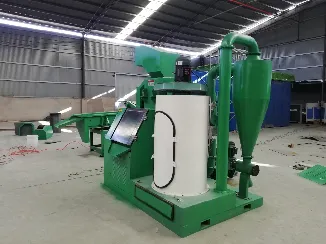

តុលា . 18, 2024 10:32 Back to list
The World of Metal Shreds Understanding Its Importance and Applications
In the ever-evolving landscape of manufacturing and recycling, metal shreds play a pivotal role in various industries. These small, fragmented pieces of metal are not merely byproducts; they represent a significant resource that can be reclaimed, recycled, and repurposed in a sustainable manner. Understanding metal shreds involves delving into their generation, processing, and application across diverse fields.
Metal shreds primarily originate from the machining, fabrication, and demolition processes. For instance, when metal components are turned, drilled, or cut during production, excess material is often stripped away, resulting in shavings or shreds. Similarly, industrial operations such as metal stamping and riveting generate shreds during the creation of parts and components. In demolition and construction, outdated or unwanted metal structures are dismantled, producing a vast array of shreds in the process. This generation of metal shreds is not just a fact of production; it also highlights the need for responsible waste management and recycling processes.
The recycling of metal shreds is crucial from both an economic and ecological perspective
. Recycling allows for the recovery of valuable materials, which can significantly reduce the need for mining and processing virgin metals. Metals such as aluminum, copper, and steel can all be recycled from shreds, leading to cost savings in production and a decrease in greenhouse gas emissions associated with mining activities. Furthermore, metal recycling requires less energy compared to the extraction of raw materials, making it a more sustainable choice in manufacturing practices.
Processing metal shreds involves several steps, including sorting, shredding, and refining. Initially, metal shreds are collected and sorted based on their material type and quality. Advanced technologies, such as magnetic separation and eddy current systems, are employed to effectively separate different metals, ensuring high-quality output for recycling. Once sorted, the shreds undergo further shredding to achieve a uniform size that is easier to handle and process. Finally, these metal fragments can be melted down and reformed into new products, contributing to a closed-loop system in manufacturing.
The applications of recycled metal shreds are vast and varied. They find immense utility in industries such as automotive manufacturing, construction, and electronics. For example, recycled steel shreds are integral in creating new steel products, including beams, sheets, and automotive parts. Similarly, aluminum shreds can be recast into new aluminum items, from beverage cans to aerospace components. The recycling of metal shreds not only fulfills industrial demand but also enhances product lifecycle sustainability.
In conclusion, metal shreds are more than just scrap; they are a valuable resource that embodies the principles of recycling and sustainability. Their generation from various industrial processes underscores the importance of efficient waste management practices. Processing these shreds not only promotes ecological responsibility but also boosts economic efficiency within manufacturing sectors. As industries continue to embrace sustainable practices, the role of metal shreds in shaping a circular economy will undoubtedly grow, promoting the notion that every fragment of metal holds potential for a new life.
Latest news
Troubleshooting Common Eddy Separator Problems
NewsJul.04,2025
The Role of Metal Recycling Plants in Circular Economy
NewsJul.04,2025
The Impact of Recycling Line Pickers on Waste Management Costs
NewsJul.04,2025
Safety Features Every Metal Shredder Should Have
NewsJul.04,2025
How Industrial Shredders Improve Waste Management Systems
NewsJul.04,2025
How Cable Granulators Contribute to Sustainable Recycling
NewsJul.04,2025